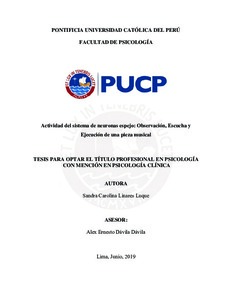El sistema se apagará debido a tareas habituales de mantenimiento. Por favor, guarde su trabajo y desconéctese.
Actividad del sistema de neuronas espejo: observación, escucha y ejecución de una pieza musical
| dc.contributor.advisor | Dávila Dávila, Alex Ernesto | es_ES |
| dc.contributor.author | Linares Luque, Sandra Carolina | es_ES |
| dc.date.accessioned | 2019-07-16T20:34:55Z | es_ES |
| dc.date.available | 2019-07-16T20:34:55Z | es_ES |
| dc.date.created | 2019 | es_ES |
| dc.date.issued | 2019-07-16 | es_ES |
| dc.identifier.uri | http://hdl.handle.net/20.500.12404/14593 | |
| dc.description.abstract | Es importante comprender los correlatos neuronales de mecanismos asociados a la ejecución de piezas musicales como efecto de exposición a estímulos de tipo auditivo y visual, ya que podría impulsar la investigación de estrategias de terapia que tengan efectos beneficiosos sobre la salud psicológica y física empleando tareas de sonido y movimiento musicales para involucrar al sistema de neuronas espejo. En ese marco, la presente investigación tuvo como objetivo determinar la actividad del sistema de neuronas espejo. Para ello, se registró la actividad cerebral de seis participantes (tres hombres y tres mujeres) con edades entre 22 y 24 años con un equipo BIOPAC MP160 durante cuatro condiciones experimentales. Las tres primeras consistieron en observar, escuchar o ejecutar una pieza musical sencilla. Por otra parte, la condición de control consistió en observar la interpretación de dicha pieza, adoptando la postura como si fueran a ejecutar la pieza en el instrumento, pero sin hacerlo. Se calculó la desincronización relacionada a eventos en cada condición experimental y en dos bandas de frecuencia. Pruebas de Wilcoxon mostraron que existió desincronización en las condiciones de control, escucha, observación y ejecución. Sin embargo, solo se hallaron diferencias significativas de esta actividad entre los efectos de las condiciones observación y control en la banda alfa. Mientras que, en la banda beta, la condición ejecución presentó diferencias significativas con las condiciones observación y escucha, y entre la condición control y escucha. Se discuten estos hallazgos, así como las limitaciones del estudio y futuras líneas a seguir. | es_ES |
| dc.description.abstract | It is important to understand the neuronal correlates of mechanisms associated with the execution of musical pieces as an effect of exposure to auditory and visual stimuli, since it could promote the research of therapy strategies that may have beneficial effects on psychological and physical health using, using musical sound and movement tasks to involve the mirror neuron system. In this context, the present research aimed to determine the activity of the mirror neuron system. To do this, the brain activity of six participants (three men and three women) aged between 22 and 24 years was recorded with a BIOPAC MP160 during four experimental conditions. The first three consisted of observing, listening or playing a simple musical piece. Similarly, the control condition consisted in observing the interpretation of that piece, adopting the posture as if they were going to perform the piece in the musical instrument, but without doing so. The event-related desynchronization was computed in each experimental condition and in two frequency bands. Wilcoxon tests showed that there was desynchronization in the conditions of control, listening, observation and execution. However, significant differences of this activity were only found between the observation and control conditions effects in the alpha band. While, in the beta band, there were significant differences between the execution condition and the observation or listening conditions, and between the control and listening conditions. These findings are discussed, as well as the limitations of the study and future lines to follow. | es_ES |
| dc.language.iso | spa | es_ES |
| dc.publisher | Pontificia Universidad Católica del Perú | es_ES |
| dc.rights | info:eu-repo/semantics/openAccess | es_ES |
| dc.rights.uri | http://creativecommons.org/licenses/by-nc-sa/2.5/pe/ | * |
| dc.subject | Neuronas espejo | es_ES |
| dc.subject | Electroencefalografía | es_ES |
| dc.subject | Música--Estudio y enseñanza | es_ES |
| dc.title | Actividad del sistema de neuronas espejo: observación, escucha y ejecución de una pieza musical | es_ES |
| dc.type | info:eu-repo/semantics/bachelorThesis | es_ES |
| thesis.degree.name | Licenciado en Psicología con mención en Psicología Clínica | es_ES |
| thesis.degree.level | Título Profesional | es_ES |
| thesis.degree.grantor | Pontificia Universidad Católica del Perú. Facultad de Psicología | es_ES |
| thesis.degree.discipline | Psicología con mención en Psicología Clínica | es_ES |
| renati.discipline | 313026 | es_ES |
| renati.level | https://purl.org/pe-repo/renati/level#tituloProfesional | es_ES |
| renati.type | https://purl.org/pe-repo/renati/type#tesis | es_ES |
| dc.publisher.country | PE | es_ES |
| dc.subject.ocde | https://purl.org/pe-repo/ocde/ford#5.01.00 | es_ES |






